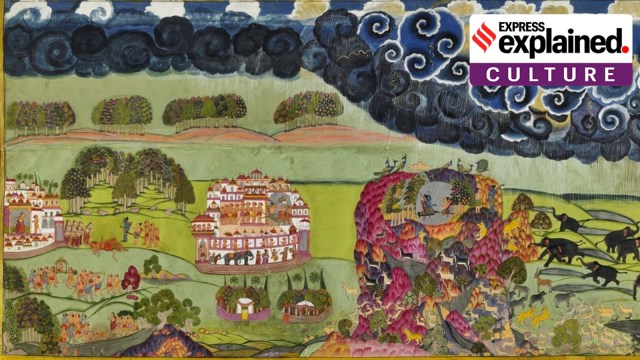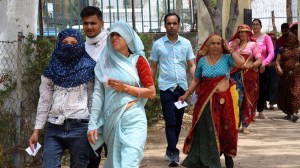- India
- International
Ramcharitmanas included in UNESCO’s Memory of the World Regional Register: Its significance
Officials behind the nomination process have told the Indian Express that the three texts were picked due to their enduring worldwide appeal.
 Illustration from the Ramcharitmanas of Tulsidas. (Photo: Wikimedia Commons)
Illustration from the Ramcharitmanas of Tulsidas. (Photo: Wikimedia Commons)Three Indian literary works, Ramcharitmanas, Panchatantra, and Sahṛdayaloka-Locana, were added to UNESCO’s Memory of the World Asia-Pacific Regional Register during the tenth meeting of the Memory of the World Committee for Asia and the Pacific (MOWCAP), held earlier this week in Ulaanbaatar, Mongolia.
Here is a look at the significance of the works, what the Memory of the World (MOW) register is, and other texts that have been included in the register this year.
What is the significance of the works?
The inclusion of the three works in the register highlights the significance of preserving and celebrating diverse narratives and artistic expressions that shape our shared humanity, the Ministry of Culture said in a statement on Monday (May 13). “These literary works have transcended time and place, leaving an indelible mark on readers and artists both within and outside India,” the ministry said.
Officials behind the nomination process have told The Indian Express that the three texts were picked due to their enduring worldwide appeal. For instance, the Ramayana and Ramcharitmanas are read in not only India but also in other Southeast Asian countries such as Cambodia, Thailand, Sri Lanka, and Indonesia, Ramesh Chandra Gaur, Head of the Department, Kala Nidhi Division at Indira Gandhi National Centre for the Arts (IGNCA), the nodal agency for sending nominations for the list.
Two Ramacharitmanas manuscripts were sent to UNESCO — one authored by Goswami Tulsidas and the other one written in Arabic in the 18th century, highlighting the appeal of the text for West Asia and other parts of the world as well, according to Gaur.

The Panchatantra fables were zeroed in owing to their universal moral values. The 15th-century Sahṛdayaloka-Locana, by Kashmiri scholars Acharya Anandvardhan and Abhinavagupta, was chosen because of its aesthetics.
This is the first time since the MOWCAP was formed in 2004 that India has sent any nominations, and all three sent by the country have been accepted.
What is the Memory of the World (MOW) register?
UNESCO’s MOW programme is an international cooperation strategy aimed at safeguarding, protecting, and facilitating access to and the use of documentary heritage, especially heritage that is rare and endangered. According to its charter, UNESCO launched the initiative in 1992 “to guard against collective amnesia” by calling upon the preservation of invaluable archive holdings and library collections all over the world and ensuring their wide dissemination.
The programme recognises documentary heritage of international, regional and national significance, maintains registers of it, and awards a logo to identified collections. It facilitates preservation and access without discrimination. It campaigns to raise awareness of the documentary heritage to alert governments, the general public, businesses and commerce to preservation needs and to raise funds.
Inscription on the register affirms the significance of the documentary heritage, makes it better known, and allows for greater access to it, thereby facilitating research, education, entertainment, and preservation over time.
What are the other items on the list?
There are 494 inscriptions on the International MoW Register, as of May 2023, according to the UNESCO website. However, the MoW register operates on regional levels as well. The Memory of the World Asia-Pacific Committee (MOWCAP) — which has now included the three Indian texts — celebrates Asia-Pacific achievements in genealogy, literature, and science. Along with the three Indian items on the list, the Member States inscribed 20 items during the 2024 cycle, at the tenth General Meeting in Ulaanbaatar.
These included three each from China and Indonesia, and two each from Malaysia, Mongolia, the Philippines, and Uzbekistan. Documents recording significant innovations in business and industrial technology were recognised, such as tea-drinking business entrepreneurship in China, as well as globally applied sugar research and regional cement production in Indonesia. Regional literary traditions were celebrated through the recognition of the Philippines’ Indigenous Hinilawod chants, the East Asian legend of the Nine Tripods found on the bronze bas-reliefs in Viet Nam’s Nine Dynastic Urns.
The 2024 cycle also celebrated science and literature, by recognising Bangladesh’s sci-fi feminist author, Rokeya S Hossain, who imagined both helicopters and solar panels before they had been invented in her 1905 utopian narrative, Sultana’s Dream; also inscribed in 2024 was Australia and Tuvalu’s joint documentation on the findings of scientific expeditions investigating the formation of coral reefs. Since it was established in 1998, the MOWCAP Regional Register has inscribed 65 items from Asia-Pacific countries.
More Explained
EXPRESS OPINION
Jun 01: Latest News
- 01
- 02
- 03
- 04
- 05
































